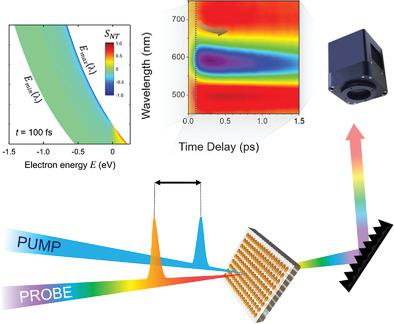当前位置:
X-MOL 学术
›
Laser Photonics Rev.
›
论文详情
Our official English website, www.x-mol.net, welcomes your
feedback! (Note: you will need to create a separate account there.)
Disentangling the Temporal Dynamics of Nonthermal Electrons in Photoexcited Gold Nanostructures
Laser & Photonics Reviews ( IF 9.8 ) Pub Date : 2021-04-24 , DOI: 10.1002/lpor.202100017 Patrick O'Keeffe 1 , Daniele Catone 2 , Lorenzo Di Mario 2 , Francesco Toschi 1 , Michele Magnozzi 3 , Francesco Bisio 4 , Alessandro Alabastri 5 , Remo Proietti Zaccaria 6, 7 , Andrea Toma 6 , Giuseppe Della Valle 8, 9 , Alessandra Paladini 1
Laser & Photonics Reviews ( IF 9.8 ) Pub Date : 2021-04-24 , DOI: 10.1002/lpor.202100017 Patrick O'Keeffe 1 , Daniele Catone 2 , Lorenzo Di Mario 2 , Francesco Toschi 1 , Michele Magnozzi 3 , Francesco Bisio 4 , Alessandro Alabastri 5 , Remo Proietti Zaccaria 6, 7 , Andrea Toma 6 , Giuseppe Della Valle 8, 9 , Alessandra Paladini 1
Affiliation

|
The study of nonthermal electrons, generated upon photoexcitation of plasmonic nanostructures, plays a key role in a variety of contexts, from photocatalysis and energy conversion to photodetection and nonlinear optics. Their ultrafast relaxation and subsequent release of energy to a low energy distribution of thermalized hot electrons has been the subject of a myriad of papers, mostly based on femtosecond transient absorption spectroscopy (FTAS). However, the FTAS signal stems from a complex interplay of different contributions arising from both nonthermal and thermal electrons, making the disentanglement of the two a very challenging task, so far accomplished only in terms of numerical simulations. Here a combined approach is introduced, based on a post-processing of the FTAS measurements guided by a reduced semiclassical model, the so-called extended two-temperature model, which has allowed the purely nonthermal contribution to the pump-probe experimental map recorded for 2D arrays of gold nanoellipsoids to be isolated. This approach displays the intimate correlation between electron energy and probe photon energy on the ultrafast time-scale of electron thermalization. It also sheds new light on the ultrafast transient optical response of gold nanostructures, and will help the development of optimized plasmonic configurations for nonthermal electrons generation and harvesting.
中文翻译:

解开光激发金纳米结构中非热电子的时间动力学
对等离子体纳米结构光激发后产生的非热电子的研究在从光催化和能量转换到光电检测和非线性光学的各种环境中发挥着关键作用。它们的超快弛豫和随后将能量释放到热化热电子的低能量分布已成为无数论文的主题,主要基于飞秒瞬态吸收光谱 (FTAS)。然而,FTAS 信号源于非热电子和热电子产生的不同贡献的复杂相互作用,这使得解开两者成为一项非常具有挑战性的任务,迄今为止仅在数值模拟方面完成。这里介绍了一种组合方法,基于由简化的半经典模型引导的 FTAS 测量的后处理,所谓的扩展双温度模型,它允许对为金纳米椭球的二维阵列记录的泵-探针实验图的纯非热贡献被隔离。这种方法在电子热化的超快时间尺度上显示了电子能量和探测光子能量之间的密切相关性。它还揭示了金纳米结构的超快瞬态光学响应,并将有助于开发用于非热电子生成和收集的优化等离子体配置。这种方法在电子热化的超快时间尺度上显示了电子能量和探测光子能量之间的密切相关性。它还揭示了金纳米结构的超快瞬态光学响应,并将有助于开发用于非热电子生成和收集的优化等离子体配置。这种方法在电子热化的超快时间尺度上显示了电子能量和探测光子能量之间的密切相关性。它还揭示了金纳米结构的超快瞬态光学响应,并将有助于开发用于非热电子生成和收集的优化等离子体配置。
更新日期:2021-06-10
中文翻译:

解开光激发金纳米结构中非热电子的时间动力学
对等离子体纳米结构光激发后产生的非热电子的研究在从光催化和能量转换到光电检测和非线性光学的各种环境中发挥着关键作用。它们的超快弛豫和随后将能量释放到热化热电子的低能量分布已成为无数论文的主题,主要基于飞秒瞬态吸收光谱 (FTAS)。然而,FTAS 信号源于非热电子和热电子产生的不同贡献的复杂相互作用,这使得解开两者成为一项非常具有挑战性的任务,迄今为止仅在数值模拟方面完成。这里介绍了一种组合方法,基于由简化的半经典模型引导的 FTAS 测量的后处理,所谓的扩展双温度模型,它允许对为金纳米椭球的二维阵列记录的泵-探针实验图的纯非热贡献被隔离。这种方法在电子热化的超快时间尺度上显示了电子能量和探测光子能量之间的密切相关性。它还揭示了金纳米结构的超快瞬态光学响应,并将有助于开发用于非热电子生成和收集的优化等离子体配置。这种方法在电子热化的超快时间尺度上显示了电子能量和探测光子能量之间的密切相关性。它还揭示了金纳米结构的超快瞬态光学响应,并将有助于开发用于非热电子生成和收集的优化等离子体配置。这种方法在电子热化的超快时间尺度上显示了电子能量和探测光子能量之间的密切相关性。它还揭示了金纳米结构的超快瞬态光学响应,并将有助于开发用于非热电子生成和收集的优化等离子体配置。











































 京公网安备 11010802027423号
京公网安备 11010802027423号